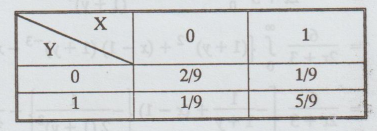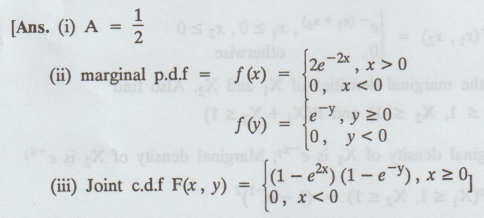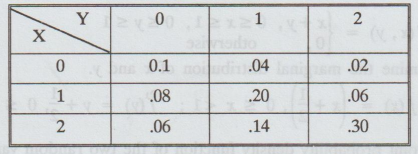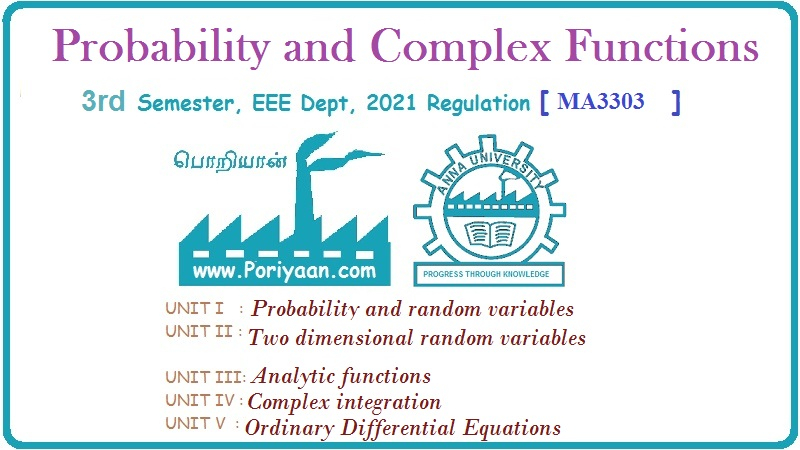Probability and complex function: Unit II: Two dimensional random variables
Exercise 2.1 (Discrete and Continuous Random Variable)
Two dimensional random variables
Probability and complex function: Unit II: Two dimensional random variables : Exercise 2.1
EXERCISE 2.1
1.
Two discrete random variables X and Y have P(X = 0,Y = 0) = 2 / 9.
P(X
= 1, Y = 1) = 5/9. Examine whether X and Y are independent.
Hint
: 
2.
The density function of a two dimensional continuous random variables is given
as

3.
Two r.v.'s X and Y have the joint p.d.f.

(i) Find (A) (ii) Find the marginal pdf (iii)
Find the joint c.d.f.

4.
Consider the two-dimensional density function

(i) Find the marginal density function.
(ii)
Find the conditional density function.

5.
Verify whether X and Y are statistically independent or not given

[Ans.
X and Y are not independent ]
6.
If X and Y have the j.p.d.f

Find
(i) P(0 < x < 1/y = 2) (ii) P(X > Y) (iii) P(X + Y < 1)
[Ans. (i) 1 – 1/e, (ii) 1/2, (iii) 1–2/e]
7.
If f (x, y) =  find
find
(i) marginal probability functions (ii)
conditional probability functions

8.
Let X1 and X2 be two r.v.'s with joint density function
given by

Find
the marginal densities of X1 and X2. Also find
P(X1
≤ 1, X2 ≤ 1) and P(X1 + X2 ≤ 1)
[Ans.
Marginal density of X1 is e-x1; Marginal density of X2
is e-x2
P(X1
≤ 1, X2 ≤ 1) = (1 - e-1)2
P(X1
+ X2 ≤ 1) = 1- 2/e]
9.
The joint probability function of two discrete r.v.'s X and Y is given by

(i) Find 'c'.
(ii) Find P(X = ≥ 1, Y ≤ 2)
[Ans.
(i) c = 1/21, (ii) P(X ≥ 1, Y ≤ 2) = 8/21]
10.
Test whether X and Y are independent or not.
f(x,
y) = Ae- | x | -2 | y |
[Ans.
independent]
11.
The joint probability density of the r.v.'s X and Y is
f(x,
y) = 1/4 e - |x| - |y| , - ∞
< x < ∞, ∞ < y < ∞.
(a)
Are X and Y statistically independent variables.
(b)
Calculate the probability that X ≤ 1 and Y ≤ 0.
[Ans.
(a) Independent ; (b) P(X ≤ 1, Y ≤ 0) = (2 - e -1)]
12.
If X and Y are two random variables, having joint density function

Determine
the marginal distribution of x and y.
[Ans. f (x) = (x + 1/2), 0 ≤ x < 1 ; f(y) =
y + 1/2, 0 ≤ y ≤ 1]
13.
The Joint probability density function of the two random variables X and Y is
given by

Find
the marginal density of X and Y.
14.
The random variables X and Y have the j.p.d.f

Find
the conditional distribution of Y given X = x.
15.
Two random variables have the j.p.d.f given by

Show
that X and Y are independent.
16.
Let X and Y be two random variables with j.p.d.f

Find
(i) the joint distribution function of X and Y, (ii) the marginal probability
density of Y.
17.
Let X and Y be jointly distributed with p.d.f.

Show
that X and Y are independent.
18.
If f (x, y) = 1 / 2x2 y for 1 ≤ x < ∞ and 1/x < y < x is
the j.p.d.f of the random variables X and Y, find
(i)
marginal distributions of X and Y.
(ii)
the conditional distribution of Y given X = x.
19.
The joint probability mass function (p.m.f) of X and Y is

Compute
the marginal p.m.f X and of Y, P [X ≤ 1, Y≤ 1] and check if X and Y are
independent. [A.U N/D. 2004]
20.
If the joint p.d.f of a two dimensional random variables (X, Y) is given by
f(x, y) = 2, 0 < y < x < 1.
=
0, otherwise
Find
the marginal density function of X and Y.
Also
find X and Y are independent. [A.U. A/M. 2003]
21.
If the joint p.d.f of (X, Y) is
f(x,
y) = 1/4 , 0 ≤ x, y ≤ 2, find P (X + Y ≤ 1).
22.
If the joint p.d.f of a two dimensional random variables (X, Y) is given by
f(x,
y) = K (6-x-y), 0 < x < 2,2 < y < 4
=
0, otherwise
Find
(i) the value K (ii) P(X < 1, Y < 3); (iii) P(X + Y < 3) and (iv) P(X
< 1 / Y < 3)
[A.U.
2003] [A.U CBT Dec. 2009] [AU N/D 2009]
23.
Find 'k' if the joint probability density function of a bivariate random
variable (X, Y) is given by

24.
Find k if the bivariate random variable X and Y has the p.d.f
ƒ
(x, y) = k x2 (8 − y), x < y < 2x, 0 ≤ x < 2
25.
If X and Y have joint p.d.f.
Check
whether X and Y are independent.
26.
Find the marginal density functions of X and Y, if
f(x,
y) = 2/5 (2x+5y), 0 < x < 1, 0 < y < 1
27.
The joint p.d.f of the two dimensional random variable is

(i) Find the marginal density functions of X
and Y.
(ii) Find the conditional density function of Y given X = x
28.
The joint p.d.f of X and Y is given by

29.
The joint p.d.f of a two dimensional random variable (X, Y) is given by f (x, y) = xy2 + x2/8, 0 ≤ x ≤ 2, 0 ≤
y ≤ 1. Compute
(i)
P (X > 1/Y < 1/2)
(ii)
P [ Y < 1/2 / X > 1]
(iii)
P [X < Y]
(iv) P(X + Y ≤ 1]
30.
The joint p.d.f of a bivariate R.V (X, Y) is given by

(i)
Find k
(ii)
Find P (X + Y < 1)
(iii)
Are X and Y independent random variables
31.
Let X and Y be two random variables with the joint p.d.f

(i) Find the marginal p.d.f of X and YX)

(iii)
Check X and Y are independent
(iv)
Find E [X] and E [Y]
Probability and complex function: Unit II: Two dimensional random variables : Tag: : Two dimensional random variables - Exercise 2.1 (Discrete and Continuous Random Variable)
Related Topics
Related Subjects
Probability and complex function
MA3303 3rd Semester EEE Dept | 2021 Regulation | 3rd Semester EEE Dept 2021 Regulation
